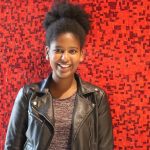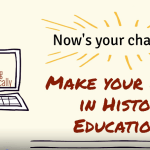Doing History: Profiles of people working in history but not necessarily as history teachers. The profile below is particularly relevant for reconciliation.
Risa Gluskin e-interviewed Krista McCracken, one of the editors of Active History. She is an Archives Supervisor at Algoma University’s Arthur A. Wishart Library and Shingwauk Residential Schools Centre.
What did you want to “be” when you were in high school?
In high school I wanted to be an English or history teacher. I knew I was really interested in both of those subjects but had no idea how to turn that interest into a job outside of becoming a teacher.
What were history classes like for you in high school?
I loved history classes in high school. The teacher I had for a world history class was particularly memorable and was one of the main reasons I went on to study history at university.
Did you study ‘public history’? If so, how did you find out about this field?
I have an MA in public history from Western University. I found out about public history in the third year of my undergrad degree when a social history professor mentioned it in passing. Later in my fourth year when I was trying to decide what to do upon graduation I got back in touch with that professor and he connected me with practicing public historians who provided advice on educational paths.
How did you get onto the educational path toward archives?
I fell into archives almost by accident. Prior to completing my MA in public history I had very little exposure to archives, most of my volunteer and work experience was related to museums and I really thought that was where I would end up. My first job out of school was working as a Digitization Facilitator helping small museums, libraries, and archives place their history collections online. That job really opened my eyes to the range of work and possibilities within the archival field and helped me hone some of the transferable skills I now use on a regular basis.
How did you get involved with Active History?
I attended the first Active History conference that was held at Glendon College in 2008. Following the conference I started following the site and was blogging on my own website. In 2010 editor Ian Milligan asked via twitter if I would be interested in contributing occasional posts to Active History. In 2011 I joined the Active History editorial collective.
Are you seeing an interest in Reconciliation amongst high school students (if you come into contact with them)?
Over the past six years while working at the Shingwauk Residential Schools Centre (SRSC) I have seen a huge increase in students interested in learning about residential schools and reconciliation. At the high school level more and more students are genuinely interested in how they can connect with survivors, start conversations about residential schools, and change the way we learn about Indigenous communities.
This has perhaps been most profound when I engaged high school students in the Project of Heart. During this learning activity they learn about residential schools, often speak with a residential school survivor, and engage in a gesture of reconciliation of some kind. The students really understand the importance of learning about residential schools and reconciliation work.
Could you talk about some examples of how you’re adapting your practices to be more culturally sensitive.
Working in the SRSC has been a huge learning curve for me. When I was first hired at the Centre most of knowledge of residential schools came from academic sources and I had very little firsthand experience working with Indigenous communities.
Since 2010 I have been very fortunate to work closely with members of the Children of Shingwauk Alumni Association (CSAA), a residential school survivor organization, and a number of inspirational Indigenous colleagues. These individuals have been hugely influential in how I’ve changed my perspectives and my professional practice.
Some of these changes have been small such as making sure that any time I’m speaking in front of a group I acknowledge the traditional territory I’m on and acknowledge the survivors and intergenerational survivors who I work with. I am a settler engaged in teaching about residential schools and I want to make it clear to everyone where I’m coming from.
I’ve also spent a lot of time considering the way in which I describe archival material. Archival descriptive standards in Canada do not readily allow for the integration of community knowledge or Indigenous world views. I’ve worked to create practices which allow for the integration of traditional knowledge into Euro-Canadian archival practices.
Working in the field, you experiences real-life ethical challenges. Could you elaborate on one. [The story about the nameless photographs is so intriguing].
One of the ethical challenges I’ve been faced with while working in the Shingwauk Residential Schools Centre involves how to handle residential school photographs that contain images of children. Most residential school images were taken by government or church staff involved in the IRS system. Many of these photographs contain students who are unidentified. Given the colonial nature of residential school system the students did not have a choice as to if they were photographed or not. Many students left the residential school system without ever having seen a photographs of themselves, despite the fact that their photograph may have been taken many times.
The challenge associated with these images is two-fold: how to you go about identifying the students in the photographs and connecting them back to the Indigenous communities that they are associated with? And how do you display these images that were taken without consent? In some cases this has meant trying to find a balance between copyright (which is typically held by the photographer or staff member who took the photograph) and Indigenous intellectual property rights which reflects the rights of the Indigenous people photographed. It has also involved a lot of community outreach and listening to the survivor community to learn how they want these images displayed.
Do you have any advice for teachers as they make the journey toward Reconciliation with their classes?
Reconciliation can mean different things to different people but one of my favourite definitions came from Senator Murray Sinclair while he was serving as chair of the TRC: “Reconciliation is about forging and maintaining respectful relationships.” Reconciliation isn’t something that happens by accident, it takes work and a lot of effort.
It’s important to realize that reconciliation is going to take time and that you’re going to make mistakes along the way. You’re going to say the wrong thing at some point and you won’t ever have all the answers. That’s okay. The main thing is to learn from your mistakes and to keep moving forward.


